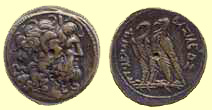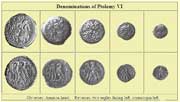Coins of the Ancient Egyptians - Ptolemaic Dynasty: 323 to 30 BC
|
|
|
This website gives a convincing answer to the question "Why did the Ptolemaic mint place the image of two eagles on so many of its bronze coins?" |
|
|
Based on countermarks, coin types and coin hoards, this website corrects a recently published faulty attribution for coins of Ptolemy VI.
|
|
|
|
This website shows that two types of Cypriot bronze coins frequently attributed to Ptolemy XII (80-51 BC) were clearly issued by his daughter Cleopatra VII and her co-regent Caesarion (44-30 BC). |
|
|
|
This bronze coin, with an obverse female head showing corkscrew locks, a wreath of barley, and the legend QUEEN CLEOPATRA, represents Cleopatra I (180-176 BC) as Isis. |
|
|
|
This review of the bronze coins of Ptolemies II, III, IV, V and VI shows that the Ptolemaic mint did not have a policy of denominational marking. As in the third century, denominational indication was by weight/size. |
|
|
|
An analysis of weight/size data shows that there are serious flaws in a recently presented chronology for 2nd century bronze coinage. |
|





